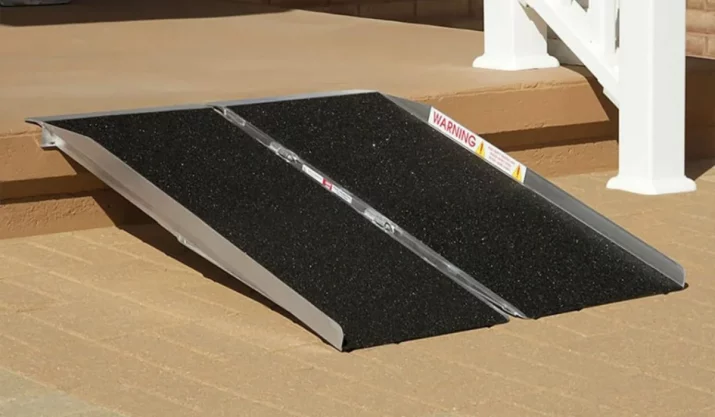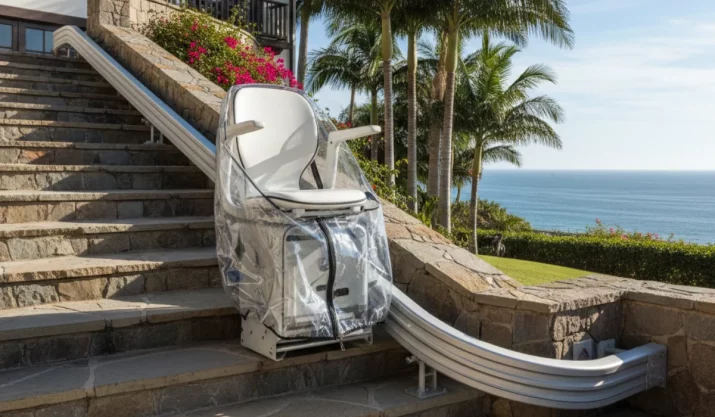Is a Portable Ramp the Right Solution for Your Home?

Table of Contents
If you or someone in your home uses a wheelchair or mobility scooter, you’ve likely looked into wheelchair ramps. But with so many types out there, portable wheelchair ramps, modular ramps, ramp kits, stair lifts, how do you know what’s best?
For many families in California, a portable ramp can be a simple, affordable way to make their homes more accessible. But that doesn’t mean it works for every home.
This article will help you figure out when a portable ramp makes sense.
Key Takeaways
- A portable ramp works well if you need flexibility, short-term access, or something you can take with you.
- Ramp length, traction, weight capacity, setup style, and warranty all affect how safe and useful your ramp will be.
- Some homes need more support than portable ramps can offer, especially with uneven ground or complicated entryways.
- Long-term needs are better met with permanent ramp systems, stair lifts, or modular ramps built for daily use.
Should You Choose a Portable Ramp for Home Access?
If you’re looking for something flexible, easy to move, or suited for short-term use, the answer might be yes. Here are a few situations where it tends to work well:
You Need Short-Term Access
If you’re recovering from surgery or expecting a guest who uses a wheelchair, a portable ramp offers quick access without a permanent setup.
You can place a foldable or trifold ramp over stairs or curbs with ease, and move it out of the way when it’s no longer needed.
You Can’t Install a Permanent Ramp
In older California neighborhoods or historic homes, adding permanent access ramps isn’t always allowed or possible.
Portable options like a roll-a-ramp or singlefold ramp let you create wheelchair access without changing your home’s structure.
You Need to Take the Ramp With You
Some people need ramps in more than one place, like when visiting family or traveling. Portable ramps work well in these cases. Scooter ramps with a high weight capacity can be used at home or loaded into a van or RV for trips.
Your Mobility Needs Are Changing
Home mobility needs can shift over time.
If you’re starting with a walker and may use a power chair later, it makes sense to begin with a portable ramp. You can always upgrade later to a permanent ramp system, indoor stair lift, or home elevator.
Your Elevation Change Is Small
Threshold ramps are perfect for small rises between rooms or doorways.
If you’re just trying to bridge a 1- to 2-inch gap, there’s no need for a large ramp system. A non-slip, heavy-duty threshold ramp can help you cross transitions safely.
What to Look for When Choosing a Portable Ramp

When you’re choosing a portable ramp, certain features matter more than others. Here’s what to look for before you check out:
Ramp Length and Slope
Ramp length is a big deal. The longer the ramp, the gentler the slope. ADA guidelines suggest a 1:12 slope—one foot of ramp for every inch of rise. That means a 3-step porch might need a ramp that’s 18 feet long.
If you make it too short, it can become unsafe, especially for power wheelchairs or mobility scooters.
Traction and Surface Type
In California, where rain or coastal air can make surfaces slick, you’ll want a ramp with a non-skid or non-slip surface. An aluminum wheelchair ramp with grooves is a good choice.
Avoid anything smooth or painted over.
It won’t hold up well in bad weather.
Weight Capacity
Not all ramps are strong enough for power chairs or heavy scooters. Check the ramp’s weight capacity and be sure it can handle both the person and the device.
Some lightweight, foldable ramps may not be enough for larger setups.
Ramp Setup
Multi-fold and trifold ramps are great for storage and travel, but may not feel as solid underfoot. If the ramp will stay in one place for a while, look for models with handrails and a wider base to add support.
Warranty and Weather Resistance
If you’ll be using the ramp outside, especially in the sun or near salt air, look for models with a good warranty. Brands like EZ-ACCESS offer weather-resistant ramps that last longer in harsh conditions.
When a Portable Ramp Is Not the Right Solution for Your Home
A portable ramp isn’t right for every home. Here are some situations where a portable ramp may not meet your needs:
Your Home Has Multiple Elevation Changes
If your property has stairs, slopes, and a porch, a portable ramp probably won’t be enough. Modular ramps with platforms or custom stair lifts are better suited for complex transitions.
You’re Looking for a Long-Term Solution
Portable ramps are best for temporary needs.
If you plan to live in your home for many more years, a permanent access system—like a custom aluminum ramp or stair lift—will be safer and easier to use every day.
Your Doorway Is Too Narrow or Crowded
Some homes, especially older ones in California, have small doorways or tricky entrances. Portable ramps might not fit well, and even if they do, they won’t fix tight spaces.
In that case, widening the doorway or installing a home lift may be a better option.
You or Your Loved One Needs a Lot of Support
If the person using the ramp has trouble with balance or needs help from someone else, handrails are a must. Many portable ramps don’t come with handrails, and not all models meet ADA standards.
A more secure ramp system is safer in these situations.
The Ground Is Uneven
Portable ramps don’t always sit flat on uneven surfaces like gravel, grass, or cracked concrete. If your yard or walkway isn’t level, a ramp may wobble or shift.
That’s a safety risk. In these cases, leveling the ground or installing a fixed platform is a better solution.
Want Help Choosing the Right Ramp?
At California Mobility, we’ve worked with families all over the state, from Santa Barbara to Sacramento, to find the best ramp systems for their homes.
If you’re not sure whether a portable ramp is right for you, we can help you figure it out. Whether you’re dealing with a steep set of stairs, a short curb, or a tricky entryway, we’ll help you find the right fit.
Give us a call or schedule a free in-home evaluation to get started.
We’ll check your space, talk through your options, and help you choose a solution that works for your life, not just your layout.






